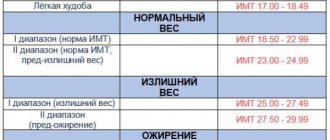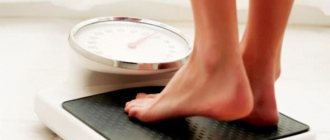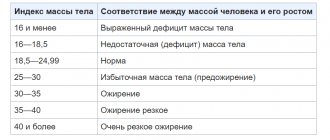Experts
- Tatyana Garats , pediatrician, department of diagnostics and rehabilitation treatment of the Federal State Budgetary Institution “SCCHD” of the Russian Academy of Medical Sciences
- Maria Petrovskaya , pediatrician, department of diagnostics and rehabilitation treatment of the Federal State Budgetary Institution “SCCHD” of the Russian Academy of Medical Sciences
- Elena Roslavtseva , Candidate of Medical Sciences, pediatrician of the highest category, highly qualified pediatric gastroenterologist and nutritionist, senior researcher, Federal State Budgetary Institution "SCCHD" RAMS
- Irina Shirokova , Candidate of Medical Sciences, endocrinologist of the highest qualification category, Federal State Budgetary Institution "SCHD" RAMS
If you want to know the height of a child, look at his mom and dad. In most cases, it is their genes that determine how tall a person will be. However, a number of factors can influence the genetically determined growth program. As a result, about 5% of children grow poorly, frightening their parents and forcing them to consult doctors.
Babies grow most noticeably in the first year of life: by about 25 cm. By the age of two they gain another 8–12 cm, by three – 7–8 cm, then the growth rate is 4–6 cm per year. Record your heir's height approximately once a year at the same time. Whether the growth is normal can most accurately be determined from the so-called central tables, which all pediatricians and other pediatric doctors have. They are also available on the Internet, but without the appropriate knowledge it is difficult to understand them. However, if a child grows less than 4 cm per year after age 4, there is indeed cause for concern.
FOR CALCULATION FANS
There are formulas that allow you to calculate your child's genetically determined height. However, their error is quite large - 5–10 cm.
Girls = (father’s height in centimeters + mother’s height in centimeters)/2 – 6.5 cm.
Boys = (father's height in centimeters + mother's height in centimeters)/2 + 6.5 cm
GENES AND FACTORS
Health problems may affect growth. For example, chronic diseases of the respiratory system, heart and blood vessels, gastrointestinal tract, hormonal disorders. Regular use of medications containing glucocorticosteroid hormones (for example, to relieve asthma attacks) also slows growth.
It happens that babies who were born with a weight and height below normal grow poorly. Despite parental care and proper nutrition, 10% of such children, even after 4 years, lag behind their peers. A similar delay may also occur in those children whose one parent is shorter than 160 cm. Just don’t panic! In most children, doctors find only so-called constitutional growth retardation. There is no pathology, but the child remains the smallest in the class for a long time. As a rule, in such children, puberty begins later - at 14–16 years old: in this way, nature extends their growth time. As a result, they usually reach their normal level without any treatment, although they are unlikely to become really high. More often, this option occurs in boys, whose parents, especially fathers, at one time grew up just as slowly.
VISIT TO AN ENDOCRINOLOGIST
Somatotropic hormone (STH) (“growth hormone”) is responsible for growth in the human body. Sex hormones of the thyroid gland and insulin are also important, but in relation to growth they are active only if there is a normal level of growth hormone. It turns out that a deficiency of one or more of the listed hormones or an excess of adrenal hormones entails growth retardation and without appropriate treatment the matter will not progress.
Fortunately, endocrine growth retardation is detected in only less than 1% of children whose parents complain about it. A real lack of growth hormone leads to nanism, or dwarfism, then boys grow no more than 140 cm, girls - up to 130 cm. The sooner parents contact an endocrinologist and receive an appointment for GH injections, the greater the chance that a small patient will grow to average height or even higher. Moreover, if the first child was diagnosed with growth hormone deficiency, and the parents are planning a second one, in most cases the second child does not repeat this hormonal problem.
BONE AGE
Bone (biological) age shows whether the growth and overall development of bones corresponds to how old and months old the child is. This is a more accurate indicator than height or body weight. In children's bones there are so-called growth zones, due to which the skeleton can increase. These growth plates gradually close towards the end of puberty, the skeleton ossifies and growth ceases. Bone age allows doctors to understand how long the child will continue to grow, whether it is necessary to look for hormonal pathology, or whether there is no reason for this. True, even in healthy children, the deviation of bone age from the real one can be up to 3 years.
Exercises to increase body height
All sets of exercises aimed at growth, one way or another, stretch the spine. But spinal traction alone is not enough; you need strong core muscles to take the pressure off your back and support your new growth.
What you need to do to develop and maintain higher growth:
- stretch the spine with exercises;
- strengthen the torso muscles;
- maintain regularity.
What exercises should you do for your spine?
These are fairly simple exercises that will quickly develop strength and flexibility.
"Cat"
Even an unprepared beginner can master “Cat”:
- Get on all fours, placing your hands on the floor. The knees should be exactly under the pelvic bones, and the palms should be under the shoulders.
- As you exhale, round your back, arching it upward. Tilt your head down.
- As you inhale, bend in the other direction. Now the pelvis and head are directed upward.
- Do 10 reps.
1
Video: Exercise “Cat”
"Cobra"
Technique:
- Lie face down on the floor with your feet together.
- Place your palms under your shoulders. Elbows pressed to the body.
- As you inhale, slowly lift your upper body off the floor.
- The lift starts from the head, then the shoulders and chest.
- Do not straighten your elbows completely; your pelvis should remain on the floor.
- Hold the final pose for 10–15 seconds, maintaining calm breathing. Slowly return to the starting position.
- Perform the exercise 3-5 times.
1
It is quite possible that the first time you will not be able to raise the body very high. This is fine. The back will stretch gradually.
Video: Exercise “Cobra”
Exercise "Boat"
The “boat” perfectly stretches the body and uses many muscles. Therefore, before the exercise you need to actively warm up so that the muscles warm up.
Technique:
- Lie face down on the floor. Arms extended forward. The body forms a straight line.
- As you exhale, lift your left arm and right leg up.
- Even if the angle of elevation is small, maintain the position for 10–20 seconds.
- As you inhale, gently lower your limbs.
- Repeat for the other leg and arm.
- Repeat the exercise 2-3 times.
1
Video: Boat exercise for healthy posture
Tilts
Bends from a standing position will help stretch the spine due to the gravity of your own body.
Technique:
- Stand straight with your feet together.
- As you inhale, raise your arms and stretch up.
- As you exhale, bend over and try to touch your feet with your hands. If you have a good stretch, grab your shins and pull your chest toward your legs.
- Hold the bend for half a minute.
- Do the exercise 3 times.
- Over time, increase the number and depth of bends.
1
Video: Bends, a set of exercises for stretching the spine
Exercises on the horizontal bar
In training on the horizontal bar aimed at growth, it is important to alternate tension with relaxation, in this case the body has time to stretch under its own weight. Let's look at what exercises are the most effective.
Simple hang on the horizontal bar
Hanging from a bar helps your spine stretch, straighten, and relax. A simple hang should not cause pain or discomfort. If this happens, you need to ease the pressure on your back and arms and support your weight with your legs.
Hang from a bar or horizontal bar, holding onto it with an overhand or underhand grip. If you are a beginner, practice hanging for as long as possible. When you bring the time of continuous hanging to 30 seconds, you can start doing simple exercises:
- move your legs left and right, forward and backward while hanging on the horizontal bar;
- bend your knees, move them up and down;
- twist the body left and right;
- move both legs simultaneously in different directions.
Perform the exercises smoothly, without swaying while hanging.
1
Video: Simple exercises for quickly stretching the spine
Pull-ups on the horizontal bar
The difference from regular pull-ups is that you need to pause 5-10 seconds between repetitions. The pause should take place in a simple hang, during which you need to relax your back as much as possible.
Technique:
- Grasp the bar with your palms facing away from you - this is an overhand grip. Place your hands slightly wider than your shoulders.
- As you exhale, pull yourself up, trying to touch your chest to the bar.
- As you inhale, lower yourself to the starting position.
- Stay in a simple hang for 5-10 seconds, relax your back.
- Repeat the exercise 10–15 times.
If you don't yet know how to do pull-ups with your own weight, use a footrest.
If possible, perform the maximum number of repetitions in each approach, preferably at least 10. Do 3-4 sets.
1
Video: Pull-ups, correct technique
Hanging Leg Raise
If you are a trained athlete, you can add weights to better stretch your spine. But only if you have no medical contraindications.
Technique:
- Hang on the bar, holding onto it with any grip.
- As you exhale, raise your legs as high as possible. If your legs are bent, pull your knees towards your chest. If your legs are straight, aim to lift them towards the bar and hold in the final position.
- As you inhale, lower your legs to the starting position, remain in a simple hang for 5-10 seconds, let your back relax.
The higher you hang your legs, the better the spine will stretch.
1
Video: Raising legs to the bar
Jumping
To increase your height, you can jump in place, with a skipping rope, or play outdoor sports games, such as basketball. The best thing for the spine is jumping with the body stretched upward. You can increase your height in 1–2 months if you perform 200 jumps a day.
Technique:
- Place your feet shoulder-width apart.
- Bend your knees, tilt your pelvis back. Keep your back straight and your knees at an angle of no more than 45 degrees. The bent knee should not go forward behind the foot.
- As you exhale, jump up while raising your arms. At the end point the body should be a straight line.
- Return to the starting position, lower your arms.
When jumping in place, try to reach with your hand any object located high. This could be a lamp or a branch. Give all your best in the jump, stretch your whole body upward.
If you can't jump without a break, jump 10 times. Fill your breaks with other back stretching exercises.
Video: Jumping technique
ALL IN OUR HANDS…
Now we come to the most interesting part: growth factors that parents can influence on their own. What's next?
- First of all, food. In order for a child to grow, the body needs everything it needs to build, first of all, long tubular bones, as well as muscles, teeth, skin and other tissues and organs. The building material is amino acids, which can only be obtained from complete protein. Therefore, 60% of protein foods should be dairy products, eggs, fish, poultry, meat - in general, animal products. Make sure that they are not very fatty, as fat inhibits the production of growth hormone.
- Plant foods should make up 40% of the diet. First of all, we are talking about cereals. Legumes are also good, but they often create digestive problems, and they still do not replace milk and meat. Vegetarianism and religious fasting are unacceptable for children! As well as fast food, semi-finished products such as sausages and sausages: there is almost no complete protein there.
- Carbohydrates provide energy for growth, but they must be obtained from the same cereals and grain dishes. Sweets that do not contain fiber also slow down the production of growth hormone! Therefore, instead of sweets, it is better to buy fruits. By the way, uncrushed cereals (buckwheat, millet, pearl barley, etc.) increase the synthesis of the necessary growth hormone.
- Vitamins and minerals are also important for growth. We are talking primarily about vitamin D, a deficiency of which develops rickets. Currently, doctors’ recommendations are to give it to all children in a prophylactic dose, approximately 10 mcg per day.
- Don't forget about calcium and iodine. The first, lying on a protein matrix, is embedded in the bones, increasing their volume and strength. The second is part of the thyroid hormones, which without it will be lacking. Therefore, at 6–10 years of age, children should receive 800–1200 mg of calcium and 150 mcg of iodine per day. And teenagers – 1200–1500 mg of calcium and 200 mcg of iodine. The best source of calcium is cottage cheese, but you can’t eat so much of it, so about half of the calcium needs to be taken in tablets. Another option is calcium-fortified foods. As for iodine, only those who live near the sea receive it in abundance: drinking water and seafood there are rich in iodine. Iodized salt is not enough, so iodine supplements are another essential for growth.
- In addition to nutrition, the general daily routine is important: the child must receive adequate emotional and physical stress and at the same time have a good rest. Then you don’t have to worry about his growth.
Methods and indications for implementation
Orthopedic surgeons use two methods to perform the operation - Ilizarov and Bliskunov. Both methods are complex surgical interventions, they are accompanied by pain and a long period of rehabilitation, so before deciding to lengthen the legs surgically, doctors recommend their patients to think carefully.
During an operation using the Ilizarov method, the doctor makes a series of incisions on the patient’s skin, uses a special instrument to cut the outer part of the bone tissue, and installs a device that will subsequently stretch the bone. Leg lengthening using the Ilizarov apparatus is very slow, painful, and the person spends most of the time in the hospital under the supervision of a doctor who is engaged in daily tightening of the fasteners.
Bliskunov’s technique has a slightly different concept, according to which a bone stretching apparatus is implanted into the bone tissue. A ratcheting mechanism remains on the outside of the lower limb, which the patient adjusts independently (the process of stretching the bone mainly occurs at home). The maximum length of leg augmentation is 16 cm (the lower leg is increased by 6 cm, and the hips by 10), but this figure depends on the method of surgical intervention and the individual characteristics of the bone tissue of each organism.
The operation is performed for aesthetic and medical reasons, which include:
disproportionate length of the lower limbs in relation to the torso;
the presence of congenital (curvature) or acquired defects in the bone tissue of the legs that prevent a person from moving normally;
limb dysplasia (impaired development of bone tissue);
improper healing of bones after a fracture;
different leg lengths;
the patient's desire to increase his height.
ALLERGY? A SMART APPROACH
There are more and more children with severe allergies to many foods at once. Pediatricians and allergists often advise them to eat an extremely monotonous diet like “rice, cauliflower and rabbit meat.” However, after a year or two, such food reveals a lack of minerals, vitamins, polyunsaturated fatty acids, and sometimes protein. Look for a middle ground: perhaps at some point it is worth tolerating, for example, moderate skin rashes, but giving the child nutritious food. Let us remind you that complete food does not mean fast food stuffed with flavoring additives and preservatives, but unusual types of meat, fish, vegetables, etc.
SLEEP IN GROWTH
Does your child love surfing the Internet at night? For the sake of high growth, you will have to give it up. 70% of growth hormone is produced between 22 and 24 hours, and only during deep sleep. It turns out that at this time both the baby and the teenager should not just go to bed, but have their tenth dream - the deepest one. At the same time, the radiation from the glowing screen of a smartphone, tablet or computer before bedtime reduces the depth of sleep, so that the production of growth hormone will again be reduced. Explain to younger family members that children under the age of 12–14 should sleep at least 10 hours, and teenagers at least 8, but doing this during daylight hours is useless!
How to increase height surgically?
The easiest way for teenagers to add 10-15 cm to their height is before the completion of the puberty cycle, while the growth zones of the body remain open. In this case, special exercises for stretching the spine, hanging on a horizontal bar and regular swimming will help you stretch out.
However, we note that adolescent training should not include heavy basic exercises with a barbell. Such exercises have a negative impact on growth, since the vertical load applied prevents the bones from growing. In addition, increased testosterone production closes growth zones.
Surgery to increase height
If growth is delayed in adolescence, the doctor may prescribe growth hormone injections, leading to enlargement of bones with open growth plates. However, this method is not suitable for adults who want to become taller. In their case, only surgical bone extraction will help to increase height.
The essence of the operation is that staples with knitting needles are installed on each leg, inserted into the surface layer of the bone; then the threaded rod is carefully extended approximately 0.25 mm four times a day. The operation adds 6-7 cm of height, but takes up to 12 months, most of which the patient spends on crutches.
***
New Fitseven materials, 5 times a week - in telegram:
- fit7seven
Regular exercises to improve posture (including the Berg technique), pumping the abdominal muscles and doing yoga can increase height, straighten your back and visually help you grow. At the same time, choosing the right clothes and styling your hair with gel can also add 3-5 cm to your height.
Scientific sources:
- Child growth: Can you predict adult height?, Jay L. Hoecker, MD, source
- Average height around the world, source
- North Korea after Kim Jong Il, The Economist, source











